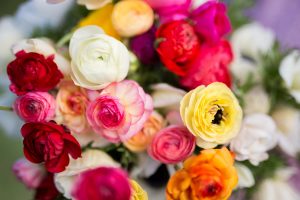By Trilby Becker, Legacy volunteer and a co-founder of the Michigan Flower Growers’ Cooperative

Trilby Becker, Legacy volunteer and co-founder of the Michigan Flower Growers’ Cooperative. Photo by Cat Buswell
As locally grown flowers become more popular, designers are increasingly daring, selecting all sorts of wild and wonderful flowers, foliages, grasses, vines, and branches for their arrangements. But traditional blooms like tulips, narcissus, ranunculus, and anemones are always in style. New varieties of these favorites are developed every year, and growers like me eagerly await the next season’s bulb catalogues to discover the fresh twists.
Spring flowers grown from bulbs and corms can be forced after a four-week chilling period at 32 degrees, but they do best when they are planted in the fall and have a 12-16 week dormancy in the ground. If that dormancy is interrupted by a warm spell, the bulbs will send out their tender shoots into temporarily warm air, only to have them smacked down by a sudden frost. At Sunseed Farm, hoop houses extend the growing and planting seasons by two months in the fall and spring. An atypically warm autumn obliged me to plant my fall bulbs in December to avoid the possibility of growth before true winter, leading to an inevitable die-off.
Two years ago I was very pleased with the abundance of blooms yielded from the two 4” by 80” beds of anemones, ranunculus and tulips planted the prior fall; so for the next season I took over a whole 30’ x 90’ hoop house, with four more beds. I considered the value of the vegetable crops we would not be growing in the hoop for the subsequent six months before deciding to go for it. I realized that I earned 25 percent more with the flower crop than I would have earned with salad mix — our most valuable cold-hardy vegetable crop. So move over mazuna and mustard, make room for Foxy Fox Trot (a hot new tulip from Holland) and her pals Sensual Touch, China Town, and of course, Renown Unique, the chubby ballerina from last year.
I also planted several new varieties of anemones and ranunculus, and my first bed of narcissus. The beds produced almost 4,000 stems from March through May, 2017. I may never triple the size of a business in one year again, so the expansion was a thrill.
Though the flowers were lovely and in demand last spring, transportation was my chief challenge. I spent more time bringing the flowers to buyers than I did growing them. Luckily, the Michigan Flower Growers’ Cooperative rode in to save the day. Once the Cooperative opened our doors last July, selling flowers became much more streamlined and efficient! I just dropped them off at the co-op on Wednesday mornings and buyers would arrive to snap them up. The co-op will reopen April 11 this year, in time to capture Sunseed Farm’s biggest crops of the season



 RSS Feed
RSS Feed